 The Ethanol Promotion and Information Council has gathered data from multiple sources that debunk claims that America’s renewable fuels are a large player in soaring food prices. Toni Nuernberg, the Executive Director of EPIC wants to spread the word that changing the nation’s renewable fuels standard is not the answer to driving down global food costs.
The Ethanol Promotion and Information Council has gathered data from multiple sources that debunk claims that America’s renewable fuels are a large player in soaring food prices. Toni Nuernberg, the Executive Director of EPIC wants to spread the word that changing the nation’s renewable fuels standard is not the answer to driving down global food costs.
Recent calls to reduce the renewable fuels standard (RFS) seem like an easy and immediate fix to world food shortages. However, the factors influencing global food prices and supplies are a result of converging global production and demand issues that go far beyond corn-based ethanol. Changing U.S. energy policy will not provide short-term relief on the food supply and decrease food prices as many expect. In fact, relaxing the renewable fuels standard mandate actually may escalate food prices now and in the future by driving fuel prices even higher.
Across the country, including 10 percent ethanol in gasoline has held the price per gallon down by $.15 to $.45 depending on the region of the country, as highlighted in recent studies in Missouri. Reducing ethanol requirements by 50 percent removes 4.5 billion gallons of ethanol from the fuel supply. This will reduce the total fuel supply, causing transportation, fertilizer, fuel, packaging and other food production costs to continue to increase, further inflating the price of food.
Long-term, repealing or suspending the 2007 Energy Policy Act is unnecessary, as technologies in use today and on the horizon will enable American farmers to increase productivity per acre to meet demands for food and this mandate, potentially with the same or fewer inputs than used today.
For many, it is easy to look past the primary factor wreaking havoc with the global economy — namely exorbitant oil prices which have increased from $35 in 2005 to more than $110 today — nearly 300 percent.
Globally, today’s energy prices are a disincentive to food production, as third world countries simply can’t afford to develop agriculture systems and, therefore, their ability to feed themselves.
Corn-based ethanol, while not a silver bullet, is the foundation upon which the next generation of “advanced biofuels” is being built.
The industry is fueling research into cellulosic ethanol produced from feedstocks such as switch grass and other non-edible renewable biomass. Corn-based ethanol is a solution that is here now, available in our current infrastructure and making a difference in the price of fuel.
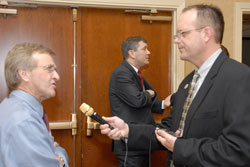 Last week I had the pleasure to spend a couple of half day sessions doing some media production training with Jennifer Morrill at American Farmland Trust in Washington, DC. It worked out very well since I was attending the NAFB Washington Watch.
Last week I had the pleasure to spend a couple of half day sessions doing some media production training with Jennifer Morrill at American Farmland Trust in Washington, DC. It worked out very well since I was attending the NAFB Washington Watch.

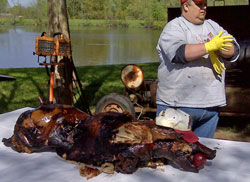 It has been a beautiful weekend in Missouri. Time to get some herbs and vegetables planted and enjoy some relaxation. On Saturday this little piggy went to, not the market, but the party at Derry Brownfield’s cabin. Mmm, mmm, good. We had quite a crowd out there.
It has been a beautiful weekend in Missouri. Time to get some herbs and vegetables planted and enjoy some relaxation. On Saturday this little piggy went to, not the market, but the party at Derry Brownfield’s cabin. Mmm, mmm, good. We had quite a crowd out there.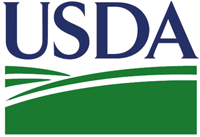 At NAFB’s Washington Watch we all received psa’s from NASS for the
At NAFB’s Washington Watch we all received psa’s from NASS for the 


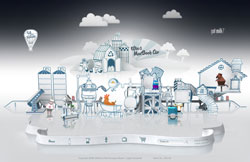 We love the commercials and now the website is more fun too.
We love the commercials and now the website is more fun too.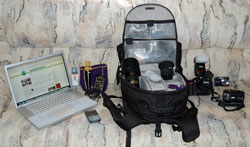
 It’s a sign to me of how much information is online when I keep finding organizations and websites I’ve never even heard of. I dare say I do spend a little bit of time in the Google world. Here’s one called the
It’s a sign to me of how much information is online when I keep finding organizations and websites I’ve never even heard of. I dare say I do spend a little bit of time in the Google world. Here’s one called the  Every once in a while the agriblogger gets caught relaxing. This time it was WFMB farm broadcaster, Leah Guffey who got the picture. I received it via MMS this morning.
Every once in a while the agriblogger gets caught relaxing. This time it was WFMB farm broadcaster, Leah Guffey who got the picture. I received it via MMS this morning.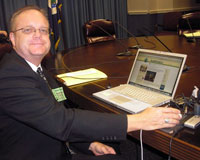 You might want to say that we’re just “early adopters” and that somehow this means that since not everyone in America is doing this or consuming this then perhaps it’s not something your company or news organization should be doing. Tempting if you’re afraid of the future I guess. However, it is the future of journalism and how people will be and are consuming information.
You might want to say that we’re just “early adopters” and that somehow this means that since not everyone in America is doing this or consuming this then perhaps it’s not something your company or news organization should be doing. Tempting if you’re afraid of the future I guess. However, it is the future of journalism and how people will be and are consuming information. 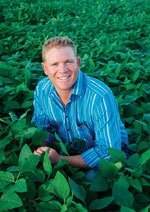 While I was attending the Commodity Classic I met the crew from CNBC that’s been following Tyler Bruch who’s a farmer and columnist for
While I was attending the Commodity Classic I met the crew from CNBC that’s been following Tyler Bruch who’s a farmer and columnist for